
Chapter Four: Walt Disney's Imagineers at Work
Looking for a Theme
Walt Disney's WED Enterprises was composed of the best and brightest personalities Walt could pull together. With backgrounds rooted in animation, art direction, architecture, design, and the fine arts, the men and women involved with the creation of Disney's Haunted Mansion were a varied group with a common goal of making the Disney theme park a destination unlike any other.
Walt Disney, always a definitive leader with a heady vision, passed away on December 15, 1966. This became a crucial matter to the design team working on the Haunted Mansion for many reasons. For one, many of them were intimately involved with Walt, and had a heavy emotional response to his passing. But a more direct threat to the project was that Walt had never made up his mind about the premise of the Haunted Mansion. He had given the WED designers lots of room to follow their passions while creating ideas and concepts for the attraction, but wasn't with the team in the end to decide definitively in which direction to take the project.
Even though it was apparent by this time that for the sake of capacity the Haunted Mansion would need to become a ride, rather than a walk-through experience, Rolly Crump recalls that Walt never was comfortable with the idea of this particular attracion becoming a ride - as one of the experiences Walt had hoped to emulate was the Hearst Castle walking tours. "He said, 'no, I want it as a walk-through,' because he was comparing it to San Simeon," Crump said. In the end, the development of the Doom Buggy (or Omnimover) system answered the question: by directing the rider's focus, the scenes in the Mansion could retain some detail without concerns about where the rider would be looking.
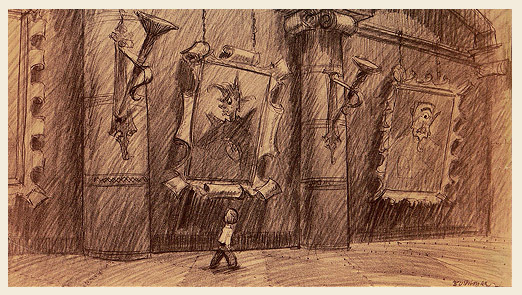
While many artists working for the Walt Disney Studios took part in the formulation and visualization of concepts for the attraction (such as art director Bruce Bushman, who contributed various ideas and storyboards such as the portrait gallery pictured above), the roster of WED employees most responsible for the Mansion's final design is a fairly short list. From the beginning, Ken Anderson had been creating various eerie storylines while Yale Gracey and Rolly Crump worked on creating a feasible method of showing guests impossible visions. Claude Coates, an accomplished art director with WED, had been working on the Mansion project and felt that the attraction could be a powerful, haunting, effects-laden spectacle - although Marc Davis, one of Disney's famed "nine old men," felt that the ride would better succeed as a character-driven, silly romp. In fact, the attraction as it exists today remains split into distinct sections: a mysterious introduction, an eerie ride with an ominous tone, and a conclusion with an overwhelming cacophony of gags and silly characters. Following are some short biographies of the men responsible for much of this merry mayhem.

Yale Gracey
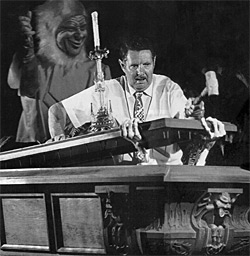
Walt knew just who to assign to the difficult job of creating the magical effects for the Haunted Mansion. Yale Gracey, one of WED's brightest engineers, was put to work on the project, and despite constant changes in the proposed theme of the attraction, his visual effects were adopted into every storyline from the start of his tenure on the project. Gracey came to WED after achieving success in Disney's animation department, having been Art Director for the 1940 classic "Fantasia." Soon after joining WED, Gracey would come to be regarded as the father of Disney theme park special effects.
- John Hench, Senior VP, Walt Disney Imagineering
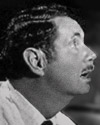 Gracey
demonstrated an eye for layout and effects and the natural ability to translate
these concepts into the three-dimensional world, so he became known for
his lighting and atmospheric effects - such as the simulated fire effect
he created for Disneyland's Pirates of the Caribbean attraction. Imagineer
Bob Gurr, who would be instrumental in the design of the omnimover system
which eventually carried guests through the Haunted Mansion, recalls working
with Gracey in an interview with "The E Ticket" magazine: "Yale
was always at the studio. He'd literally sit in his room and fiddle with
stuff, and occasionally invent something. Walt was totally happy with that...
Yale was good at figuring out physical gags. Then somebody working on a
project would find a way to weave Yale's gag into their show story. He would
often have things on the shelf that we could use later."
Gracey
demonstrated an eye for layout and effects and the natural ability to translate
these concepts into the three-dimensional world, so he became known for
his lighting and atmospheric effects - such as the simulated fire effect
he created for Disneyland's Pirates of the Caribbean attraction. Imagineer
Bob Gurr, who would be instrumental in the design of the omnimover system
which eventually carried guests through the Haunted Mansion, recalls working
with Gracey in an interview with "The E Ticket" magazine: "Yale
was always at the studio. He'd literally sit in his room and fiddle with
stuff, and occasionally invent something. Walt was totally happy with that...
Yale was good at figuring out physical gags. Then somebody working on a
project would find a way to weave Yale's gag into their show story. He would
often have things on the shelf that we could use later."
Gracey partnered up with Rolly Crump, and with Crump's assistance, he began developing the illusions for the Mansion. Walt certainly didn't make Gracey's task simple. In an interview at the time (when Walt was still referring to the future Mansion as the "New Orleans exhibit,") Walt directed Gracey to create "something nice for the Hall of the infamous part of the New Orleans exhibit... like werewolves, a Medusa, marble busts that talk, even ordinary-appearing pictures that will change into horrors before the visitors eyes."

This was part of yet another plan in which the Mansion might end up being part of a sprawling underground walk-through exhibit that described the best and the worst of "'Nawlins." Gracey got straight to work, tackling the daunting task of creating live spectral visual effects, and though the Mansion's proposed storyline and theme changed many times, many of the fully-realized effects and tricks conjured up by Gracey and Crump went on to become the Haunted Mansion's showstopping feats of "Illusioneering" (as Walt began to refer to the effects work.) Pictured to the left is a press photo of Yale Gracey posing with his see-through "Hatbox Ghost" which was based on a character designed by Marc Davis. While this character was only installed in the Mansion for weeks at most, the amazing transparent ghost effects Gracey championed are showcased in the Mansion's showstopping "Grand Ballroom" scene.

- Marty Sklar, President, Walt Disney Imagineering
Claude Coats
 Claude
Coats, a USC graduate with a degree in architecture and fine arts, started
working for Disney in 1934 as a background artist for Walt's animation studio.
Coats is largely responsible for creating the multi-textured watercolor
worlds found in the background paintings for "Snow White and the Seven
Dwarfs," "Pinocchio," and numerous other animated films,
up through 1953's "Peter Pan," after which he was picked by Walt
to join the team designing Disneyland at WED. Upon joining the team, Coats
started working on many different projects, including Pirates of the Caribbean
and many of the 1964 World's Fair attractions.
Claude
Coats, a USC graduate with a degree in architecture and fine arts, started
working for Disney in 1934 as a background artist for Walt's animation studio.
Coats is largely responsible for creating the multi-textured watercolor
worlds found in the background paintings for "Snow White and the Seven
Dwarfs," "Pinocchio," and numerous other animated films,
up through 1953's "Peter Pan," after which he was picked by Walt
to join the team designing Disneyland at WED. Upon joining the team, Coats
started working on many different projects, including Pirates of the Caribbean
and many of the 1964 World's Fair attractions.
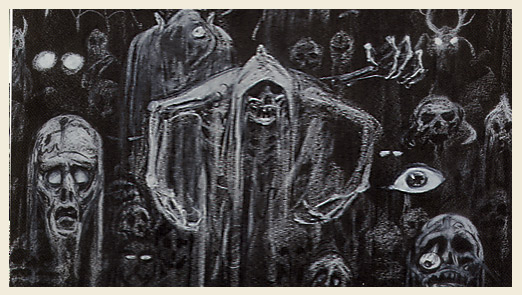
Coats is credited with pioneering the use of ultraviolet light in live special effects and three dimensional environments, proving him well-suited for designing for the dark ride format. Many of Coats' conceptual sketches for the Haunted Mansion were drawn with pastels on black art board, demonstrating his technique of pulling detail and atmosphere out of darkness (such as the sketch above, which demonstrates Coats' ideas for representing some of the Mansion's residents).
Having been very successful in creating a convincing atmosphere for Disneyland's Pirates of the Caribbean attraction, Coats sought to work in the same vein for the Haunted Mansion, creating an eerie space full of unexplainable occurences and shadowy environments.
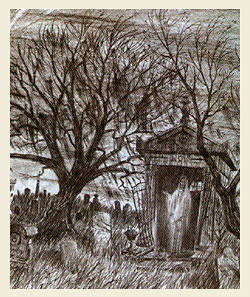
The sketch to the left shows Coats' vision of a desolate graveyard, run-down, untended, and filled with restless residents from the afterlife. The graveyard finale as it exists in the attraction today follows many of these themes and ideas quite closely, and Coats' open crypt and its occupant are even featured prominently in the scene. The whispy spirits that fly through the air and multiple-layers of scrim that simulate a deep fog that currently appear in the attraction also can be traced directly to Coats' background designs. Without a doubt, the dramatic tableau that greets visitors to the Haunted Mansion when they first emerge into the graveyard owes its character to the designs of Claude Coats.
Marc Davis
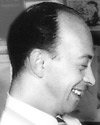 If
any Imagineer might be singled out for having left an indelible mark on
Walt Disney's parks, Marc
Davis would definitely be at the top of the list of finalists. After
a brilliant career in Disney's animation department, where Davis is credited
with creating some of Disney's most enduring characters (including Peter
Pan's Tinker Bell and Sleeping Beauty's Maleficent), Davis was
tapped by Walt to come over to WED to develop characters and set pieces
for the theme parks.
If
any Imagineer might be singled out for having left an indelible mark on
Walt Disney's parks, Marc
Davis would definitely be at the top of the list of finalists. After
a brilliant career in Disney's animation department, where Davis is credited
with creating some of Disney's most enduring characters (including Peter
Pan's Tinker Bell and Sleeping Beauty's Maleficent), Davis was
tapped by Walt to come over to WED to develop characters and set pieces
for the theme parks.
Though he came to the Mansion project a few years after the original concepts were under development, he still produced hundreds of conceptual sketches for the attraction. Besides creating dozens of ideas for various creatures and effects for the Mansion, Davis is known for designing the various "changing portraits" seen in the attraction. The old man pictured to the right, who has made an unfortunate Faustian deal with the devil, is a sample of one of Davis' changing portraits that was never used in the Mansions. In the video at right, Davis describes the artwork he created at a special live Haunted Mansion event held at Disneyland to celebrate the attraction's 30th anniversary.
In the end, Davis is responsible for nearly all of the Haunted Mansion's most recognizable characters, such as the Caretaker and Hitchhiking Ghost pictured below.
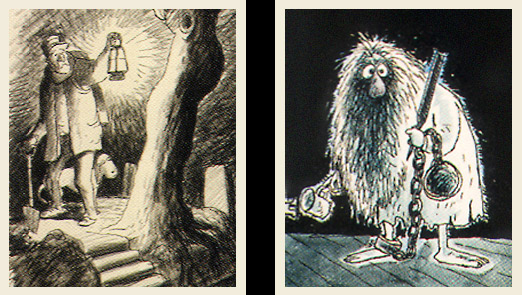
Pictured below are two of Davis' concepts for the Mansion's famous "bride in the attic." Though Davis was a proponent of keeping the Mansion attraction light-hearted, it is interesting to note that even Davis was trying to find the balance of "fright vs. light" in his concepts, with samples of both a matronly, befuddled bride and a devious, "witchy" bride holding her black cat. (The cat, incidentally, was a character that shows up in various concepts partly because in early scripts, it was considered as a possible recurring character that the Mansion's visitors could be watching for.)
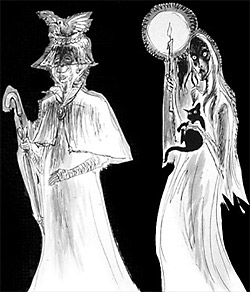
At the end of the day, Davis' involvement with the project brought strong visual character to the developing attraction. His gags, characters and set pieces (including many of the characters in the Grand Ballroom, the Singing Busts, the Hitchhiking Ghosts, and most of the set pieces in the graveyard) help define the "feel" that visitors take with them when they leave. Additionally, Davis is largely responsible for transforming the attraction from the proposed story-telling adventure into a series of set pieces and gags with narration used to tie everything together, which is how the Mansion would finally be designed.
Giving life to the concepts
 As
the conceptual artists conceived, sculptors were equally important to the
process, to be sure that the real-world representations of the various artists'
sketches and atmospheric artwork would look and feel genuine to the viewer.
"The myriad of characters at Disney parks not only entertain - they
tell the stories of the attractions," said Rick Golding, a contemporary
manager from Imagineering's sculpture division. One Imagineer key to this
processs back in 1969 was WED's Blaine
Gibson (pictured, above right). "What we had to shoot for is the
feeling that the sculpture could be alive," Gibson told Disney News
in 1993. "Sure, sculptures can be animated mechanically, but if they
already have a spark of life inherent in their creation, they work a lot
better in getting the viewer involved."
As
the conceptual artists conceived, sculptors were equally important to the
process, to be sure that the real-world representations of the various artists'
sketches and atmospheric artwork would look and feel genuine to the viewer.
"The myriad of characters at Disney parks not only entertain - they
tell the stories of the attractions," said Rick Golding, a contemporary
manager from Imagineering's sculpture division. One Imagineer key to this
processs back in 1969 was WED's Blaine
Gibson (pictured, above right). "What we had to shoot for is the
feeling that the sculpture could be alive," Gibson told Disney News
in 1993. "Sure, sculptures can be animated mechanically, but if they
already have a spark of life inherent in their creation, they work a lot
better in getting the viewer involved."
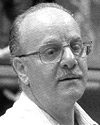 Among
Gibson's familiar Haunted Mansion creations, he is probably best known for
the iconic Hitchhiking Ghosts, and the skeletal hiker's leering skull. Adolpho
Procopio (left), another WED-era sculptor, worked with Gibson on the Haunted
Mansion project, sculpting such notable creations as the hands emerging
from the conservatory coffin, among other things. "The art of sculpting
hasn't changed much through the ages," Procopio told Disney News.
"The tools have remained very simple - mostly wire loops and wooden
spatulas. Sculptors have always relied on the sensitivity of their hands
to create their work."
Among
Gibson's familiar Haunted Mansion creations, he is probably best known for
the iconic Hitchhiking Ghosts, and the skeletal hiker's leering skull. Adolpho
Procopio (left), another WED-era sculptor, worked with Gibson on the Haunted
Mansion project, sculpting such notable creations as the hands emerging
from the conservatory coffin, among other things. "The art of sculpting
hasn't changed much through the ages," Procopio told Disney News.
"The tools have remained very simple - mostly wire loops and wooden
spatulas. Sculptors have always relied on the sensitivity of their hands
to create their work."
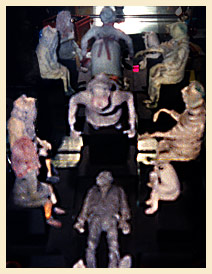 The
full-scale sculptures come about after the original designs and sketches
are translated into 3-D by creating a miniature model of the character called
a maquette (such as the Grand Hall dining table maquettes pictured at right).
"Maquettes are essential for maintaining proportions," Procopio
said. "Even Michaelangelo wouldn't build a full-size sculpture until
he had a maquette to refer to."
The
full-scale sculptures come about after the original designs and sketches
are translated into 3-D by creating a miniature model of the character called
a maquette (such as the Grand Hall dining table maquettes pictured at right).
"Maquettes are essential for maintaining proportions," Procopio
said. "Even Michaelangelo wouldn't build a full-size sculpture until
he had a maquette to refer to."
 Working
side-by-side with Gibson and Procopio was Harriet
Burns (left), a modeler and designer who worked with Imagineering from
1955 until her retirement from the Disney Company in 1986. Burns, one of
the few women in the department during WEDs early years, was involved with
everything from finishing the maquettes and models to constructing sets.
"Marc (Davis) was doing... storyboard ideas of his cartoons, and then
Blaine was responsible for sculpting," Burns told MouseClubHouse.com.
"Blaine had to incorporate the humor of Marc’s, because Marc had
a wonderful sense of humor. (Blaine) had to incorporate that as much as
he could into a three dimensional head or whatever."
Working
side-by-side with Gibson and Procopio was Harriet
Burns (left), a modeler and designer who worked with Imagineering from
1955 until her retirement from the Disney Company in 1986. Burns, one of
the few women in the department during WEDs early years, was involved with
everything from finishing the maquettes and models to constructing sets.
"Marc (Davis) was doing... storyboard ideas of his cartoons, and then
Blaine was responsible for sculpting," Burns told MouseClubHouse.com.
"Blaine had to incorporate the humor of Marc’s, because Marc had
a wonderful sense of humor. (Blaine) had to incorporate that as much as
he could into a three dimensional head or whatever."

Moving the process along: MAPO develops Audio-Animatronics

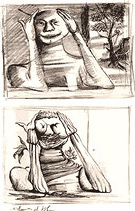 Other artists at WED worked alongside Davis, such as Edward Kahn,
who created the unused changing portrait to the left of a man becoming
a vegetable. Kahn was also responsible for taking some of Davis' sketches
and fleshing them out, or creating final paintings based on the ideas
Davis created. Nevertheless, Davis created some of the ride's most enduring
imagery. In his own words: "Walt's attitude was (to give) experiences...a
flash of this and a flash of that, everything within a subject matter.
Rides... don't have a lot to do with continuity of story. It has to
do with the entertainment value of surprise... seeing things you can't
see anywhere else."
Other artists at WED worked alongside Davis, such as Edward Kahn,
who created the unused changing portrait to the left of a man becoming
a vegetable. Kahn was also responsible for taking some of Davis' sketches
and fleshing them out, or creating final paintings based on the ideas
Davis created. Nevertheless, Davis created some of the ride's most enduring
imagery. In his own words: "Walt's attitude was (to give) experiences...a
flash of this and a flash of that, everything within a subject matter.
Rides... don't have a lot to do with continuity of story. It has to
do with the entertainment value of surprise... seeing things you can't
see anywhere else." 
Despite the high-caliber talent Walt brought to WED to design his park, many other artists, technicians, and engineers were critical to the process as well. While WED was given the task of developing the attractions at the park, MAPO, the manufacturing arm of WED, was busy developing systems to enable the Imagineers' designs to come to life in believable ways.
MAPO worked closely with WED to bring the sketches the Imagineers put on paper to life as three-dimensional characters that acted and reacted in real space. The term MAPO, incidentally, is both an acronym for "Manufacturing and Production Operation," as well as a play on the title of the film "Mary Poppins" after which the department was named for developing the first audio-animatronic - a robin with which Mary Poppins sings.
Dave Schweninger, an engineer with MAPO who led the development of Disney's audio-animatronic technology for the World's Fair installments as well as Disneyland's attractions, recalls his time working on the Haunted Mansion and other projects with Marc Davis: "Marc was my mentor, my friend, and my partner starting with the General Electric Carosel of Progress... through the Mickey Mouse Review at Walt Disney World. He was the best. I ran the animatronics department at MAPO - the mechanical design. The [characters] were sculpted by the sculptors at WED, and [MAPO handled] the control systems, and manufacturing the bodies and all the structure. All the mechanical end of it."
Obviously, the work of many staffers is involved to make the mystery of the Mansion come to life. But MAPO's development of crucial technical details, such as robotics and ride mechanisms, came just in time to make the Haunted Mansion a cutting-edge, visceral experience unlike any other seen before. Coupled with the 19th-century magician's techniques honed by Yale Gracey and Rolly Crump, and surrounded by Davis' kooky characters and Coats' eerie atmosphere, MAPO's work for the Haunted Mansion was a successful blend of mechanical engineering, dark ride design and implementation.

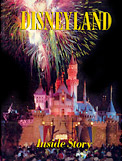
Disneyland: Inside Story
Fright vs. Light: The Big Question
At the time of Walt's death, a various scripts had been written with a definite
dark tone for the proposed ride. An excerpt from one follows:
...Our house had a tragic and bloody history of unlucky owners who died sudden and violent deaths, which resulted in their unhappy ghosts remaining behind to fulfill the uncompleted missions of their lives. We started the work of restoration as soon as it arrived at Disneyland, but strangely enough, the work of each day was destroyed during the night. It mysteriously remains always night within the house... so we recommend you stay close together during your visit, and please, above all, obey your guide's instructions...
This is clearly quite different from the eventual theme adopted for the Mansion, which consists of "silly spooks" and "grim grinning ghosts." This divergent storyline was a source of great controversy among the Imagineers. WED legend Marc Davis, who created the iconic pixie Tinkerbell for Disney's version of Peter Pan, was one of the proponents of taking the show from creepy to kooky, while Imagineer Claude Coats, who had been instrumental in creating the grand sets for Pirates of the Caribbean, wanted to create a darker, more ominous mood.
Davis recalls that the design process may have suffered from having too many cooks in the kitchen. In Disneyland: Inside Story, author Randy Bright quotes Davis as he recalls the confusion:
"Walt had not been gone that long. I think there were a lot of great ideas, but when you have too many people of equal clout, nobody's about to say, 'Hey, wait a minute! Let's do it this way,' which Walt would have done in a moment."
Randy Bright's book goes on to reveal more information about the debate between "fright" and "light." Click here to read an excerpt.




